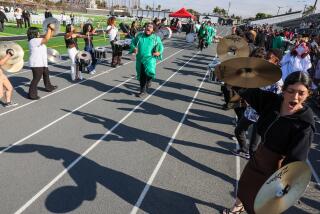TELEVISION REVIEW : TV ‘Reunion’ Lacks Energy of Its Jazz Artists
- Share via
SAN DIEGO — You really want to like “Reunion,” the KPBS-TV special on five talented jazz musicians who blossomed at Crawford High School in San Diego in the early ‘70s.
Producer Anasa Briggs-Graves mixes interviews, still photos and a live studio concert in an attempt to explain how the high school became such a font of artistic talent during an era known for Nixon’s Watergate, Olympic terrorists and the shooting of four students at Kent State.
But the half-hour program (tonight at 10 on Channel 15), is disappointingly short on musical sparks and interviews that dig below the surfaces of their subjects. And “Reunion” never gives you a sense of the times, a musical and social setting that could make it spring to life.
Briggs-Graves had known several of the players for years. After producing a program on youth gangs, she felt the need to do a show with a more positive slant on young people, she said. “Reunion” documents what happens when intelligent, motivated students hook up with an inspiring high school teacher.
The basic elements of a good program are here. We meet Dennis Foster, the Crawford High School music instructor who sparked the creativity. Among them, Nathan East has the highest profile. He plays bass behind rock guitarist Eric Clapton. Saxophonist Hollis Gentry is best known for his contemporary jazz band, Neon.
The other three are flutist Marchelle Minafee, who recently joined the San Diego group The People’s Choice, now touring Japan; Carl Evans Jr., who plays keyboards in the nationally popular San Diego jazz band Fattburger, and drummer Doug Robinson, who writes inspirational music as part of his work with Synanon, the San Francisco-based drug-rehabilitation program.
All of the musicians acknowledge the impact of Foster. Gentry recalls how the music teacher recruited him to Crawford from a junior high school band and soon became an important mentor.
“Dennis Foster was our dad and our buddy,” Gentry says.
“He knew when to back off and let something happen on its own,” Robinson remembers.
But the interviews never elicit from the subjects the kinds of insights and colorful anecdotes that would make the show special. Surely something funny or inspiring happened between these people during the Crawford years. There must have been occasions when Foster did or said something
that helped a budding artist to a musical breakthrough. There must have been musical pieces, theories or experiences the players could have recalled if pushed a little.
In the studio, the players are obviously enjoying themselves, but musically they don’t seem to connect. Some of this undoubtedly has to do with the range of directions they’ve taken in their careers. On the one hand, Gentry and East play their synthesized saxes and electric basses in a style that mixes jazz with the funk-pop sound of artists like Grover Washington Jr.
On the other hand, there’s Evans, who turns out wonderful, straight-ahead jazz on the acoustic piano, and Minafee, whose flute playing is sometimes tentative. Robinson provides a solid anchor on drums.
Replacing one or two of the five studio numbers with footage of the musicians playing with Fattburger, Clapton and Neon could have punched the energy level up a much-needed notch or two.
Visually, “Reunion” seems static and bland compared with KPBS’ “Club Date” series, which features nationally known jazz artists in live studio performances. Instead of the lively night-club ambiance of “Club Date,” enhanced by dramatic lighting and an attentive audience, what we get is flatter lighting and a seldom-seen audience that seems only marginally moved by the music.
Local jazz fans will be disappointed by the lack of revealing conversation and musical synergy. Those who know less about San Diego jazz will probably be entertained and informed. All viewers will be impressed that such a concentration of fine players developed at a San Diego high school, even if the show doesn’t give a complete sense of their lives and times.
A celebration of jazz great Charlie Parker. Page 11.
More to Read
The complete guide to home viewing
Get Screen Gab for everything about the TV shows and streaming movies everyone’s talking about.
You may occasionally receive promotional content from the Los Angeles Times.






